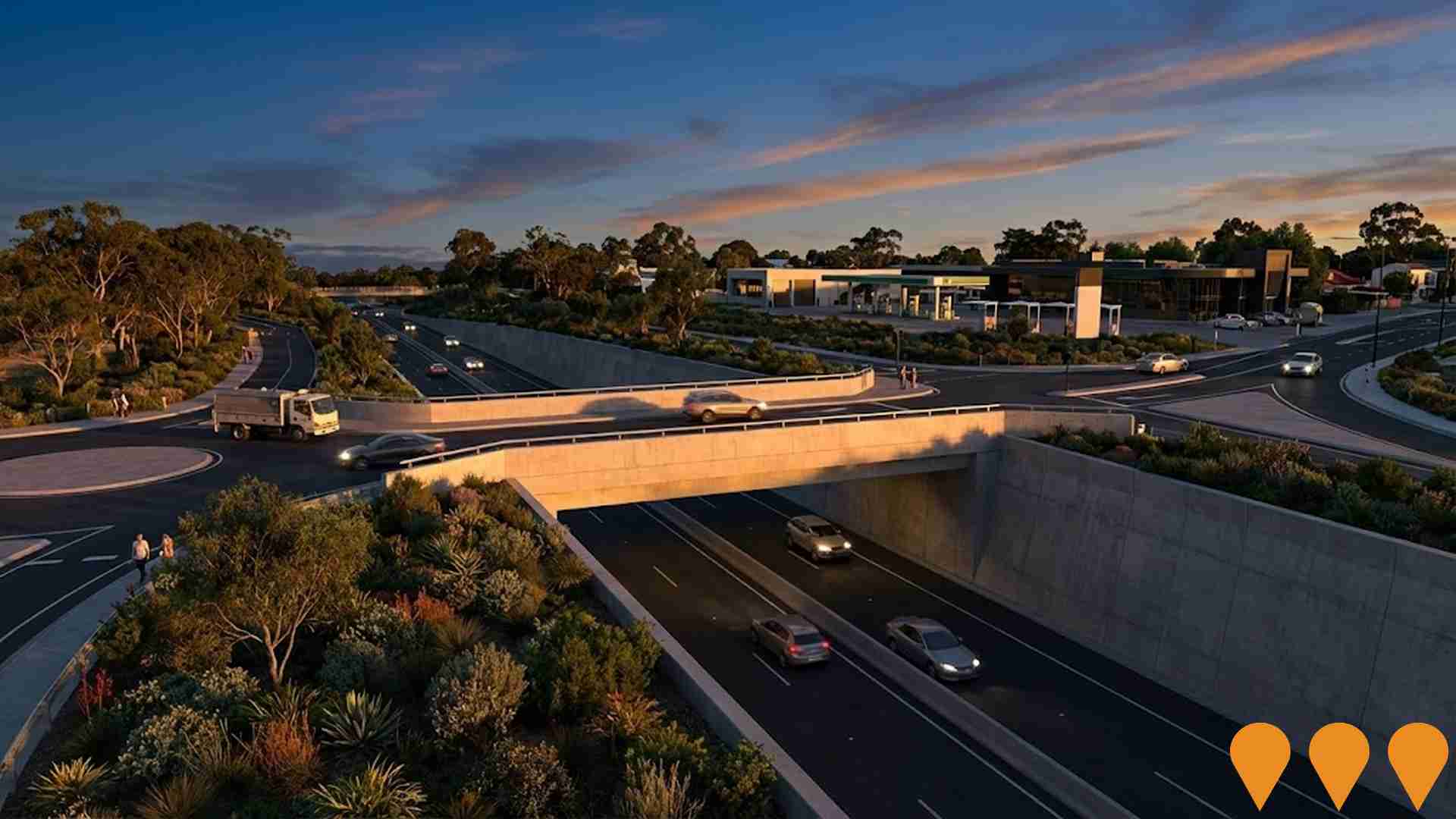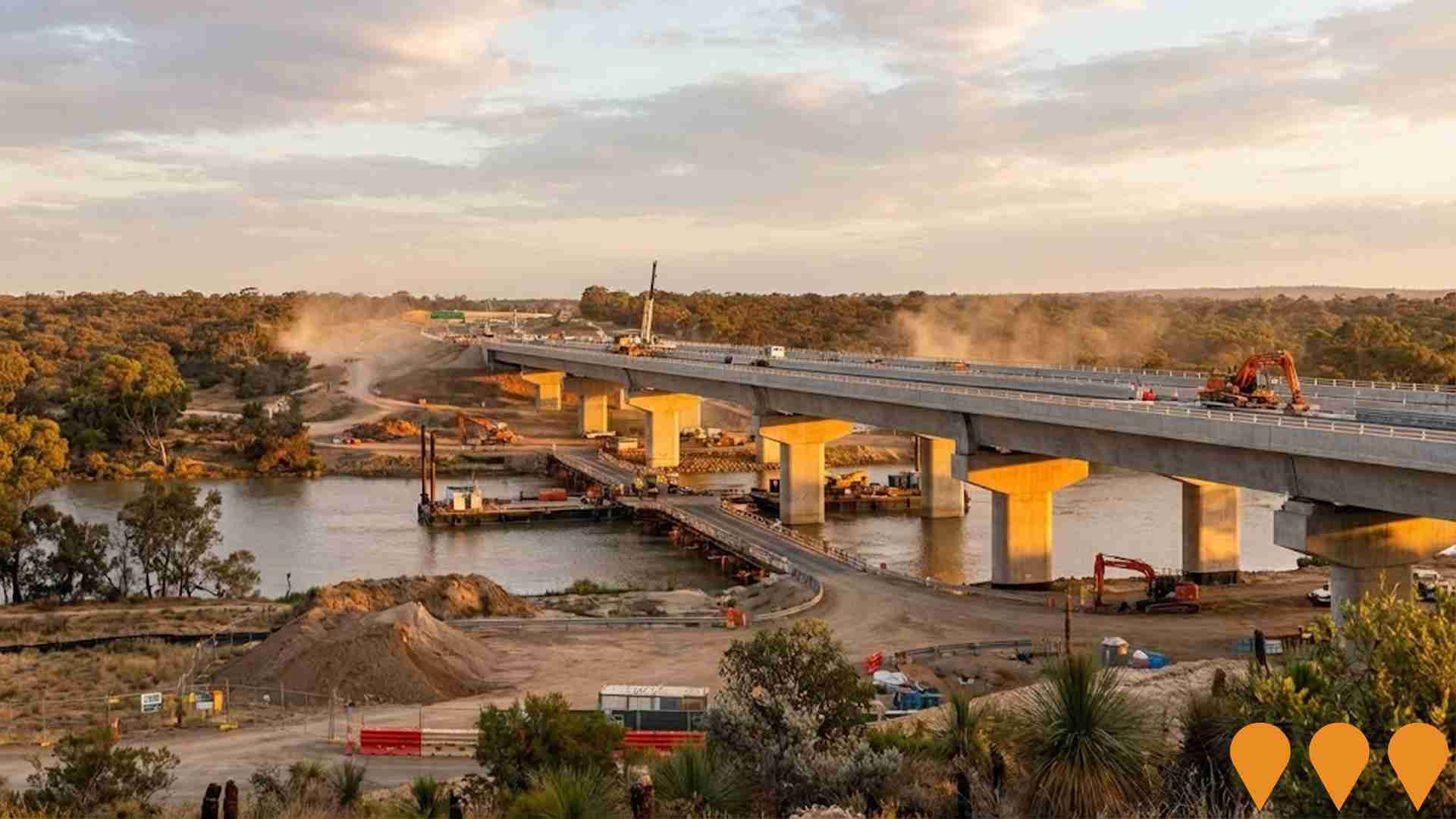Chart Color Schemes
est. as @ -- *
ABS ERP | -- people | --
2021 Census | -- people
Sales Activity
Curious about local property values? Filter the chart to assess the volume and appreciation (including resales) trends and regional comparisons, or scroll to the map below view this information at an individual property level.
Find a Recent Sale
Sales Detail
Population
Population growth drivers in Christies Beach are strong compared to national averages based on AreaSearch's ranking of recent, and medium to long-term trends
Christies Beach's population is approximately 11,648 as of August 2025. This figure represents an increase of 598 people since the 2021 Census, which reported a population of 11,050. The growth was inferred from ABS estimates and validated new addresses between June 2024 and the Census date. This results in a density ratio of 1,613 persons per square kilometer, higher than the average across national locations assessed by AreaSearch. Christies Beach's population grew by 5.4% since the 2021 census, outpacing both its SA3 area (4.8%) and SA4 region. Interstate migration contributed approximately 70.8% of overall population gains during recent periods.
For projections, AreaSearch uses ABS/Geoscience Australia data released in 2024 with a base year of 2022 for each SA2 area. For areas not covered by this data and years post-2032, the SA State Government's Regional/LGA projections based on 2021 data are adopted with adjustments made using weighted aggregation methods. Based on projected demographic shifts, Christies Beach is expected to grow by 1,686 persons to 2041, recording a gain of 14.1% in total over the 17 years.
Frequently Asked Questions - Population
Development
AreaSearch assessment of residential development activity positions Christies Beach among the top 25% of areas assessed nationwide
Christies Beach has recorded approximately 80 residential properties granted approval annually. Over the past five financial years (from FY21 to FY25), a total of 404 homes were approved, with an additional 34 approved so far in FY26. Each dwelling has attracted an average of 2.2 new residents per year over these five years, reflecting robust demand that supports property values.
The average construction cost value for new homes is $350,000, aligning with broader regional development trends. This financial year (FY26), there have been $9.2 million in commercial approvals, indicating steady commercial investment activity. When compared to Greater Adelaide, Christies Beach shows moderately higher development activity, 47.0% above the regional average per person over the past five years.
This has maintained good buyer choice while supporting existing property values. The new development consists of 66.0% standalone homes and 34.0% attached dwellings, offering a blend of housing types across various price ranges. Christies Beach has around 145 people per dwelling approval, indicating characteristics of a low density area. Population forecasts suggest Christies Beach will gain 1,638 residents by the year 2041. At current development rates, new housing supply should comfortably meet demand, providing good conditions for buyers and potentially supporting growth beyond current population projections.
Frequently Asked Questions - Development
Infrastructure
Christies Beach has emerging levels of nearby infrastructure activity, ranking in the 30thth percentile nationally
Changes to local infrastructure significantly influence an area's performance. AreaSearch has identified four projects likely impacting the area: Colonnades Shopping Centre Ongoing Upgrades, Noarlunga Hospital Mental Health Expansion, Noarlunga Master Planning Housing Project, and Noarlunga Residential Development. The following list details those most relevant.
Professional plan users can use the search below to filter and access additional projects.
INFRASTRUCTURE SEARCH
 Denotes AI-based impression for illustrative purposes only, not to be taken as definitive under any circumstances. Please follow links and conduct other investigations from the project's source for actual imagery. Developers and project owners wishing us to use original imagery please Contact Us and we will do so.
Denotes AI-based impression for illustrative purposes only, not to be taken as definitive under any circumstances. Please follow links and conduct other investigations from the project's source for actual imagery. Developers and project owners wishing us to use original imagery please Contact Us and we will do so.
Frequently Asked Questions - Infrastructure
Port Stanvac Precinct
Redevelopment of the former Port Stanvac oil refinery site into a 230-hectare coastal masterplanned community. Minimum 3,600 new homes (including at least 15% affordable housing), 40 hectares of protected coastal reserve with public beach access, local shopping centre, employment and business hub, sporting fields, and extensive public open space. Masterplan endorsed by Government. Code Amendment lodged and under public consultation in 2025.
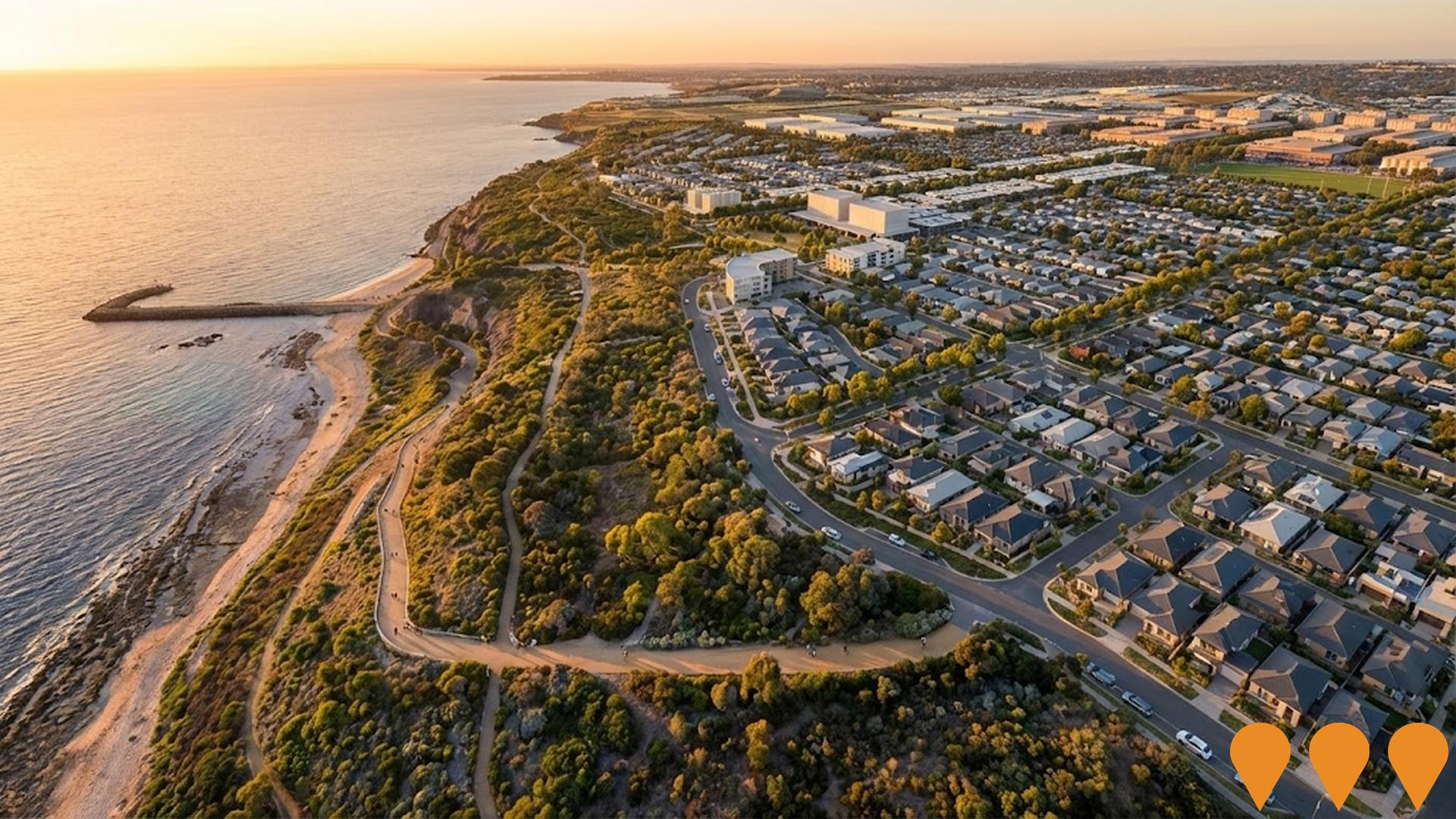
Onkaparinga Heights
A ~235 hectare masterplanned community in Adelaide's southern suburbs, delivering up to 2,000 new homes across a 67.6ha Renewal SA site (minimum 20% affordable housing) and adjacent private land. Infrastructure deeds signed, RFP closed October 2025. Features sustainable design, diverse housing options, excellent connectivity via Southern Expressway and future North-South Corridor, proximity to McLaren Vale wine region, Port Noarlunga beach, Onkaparinga River National Park and beaches.
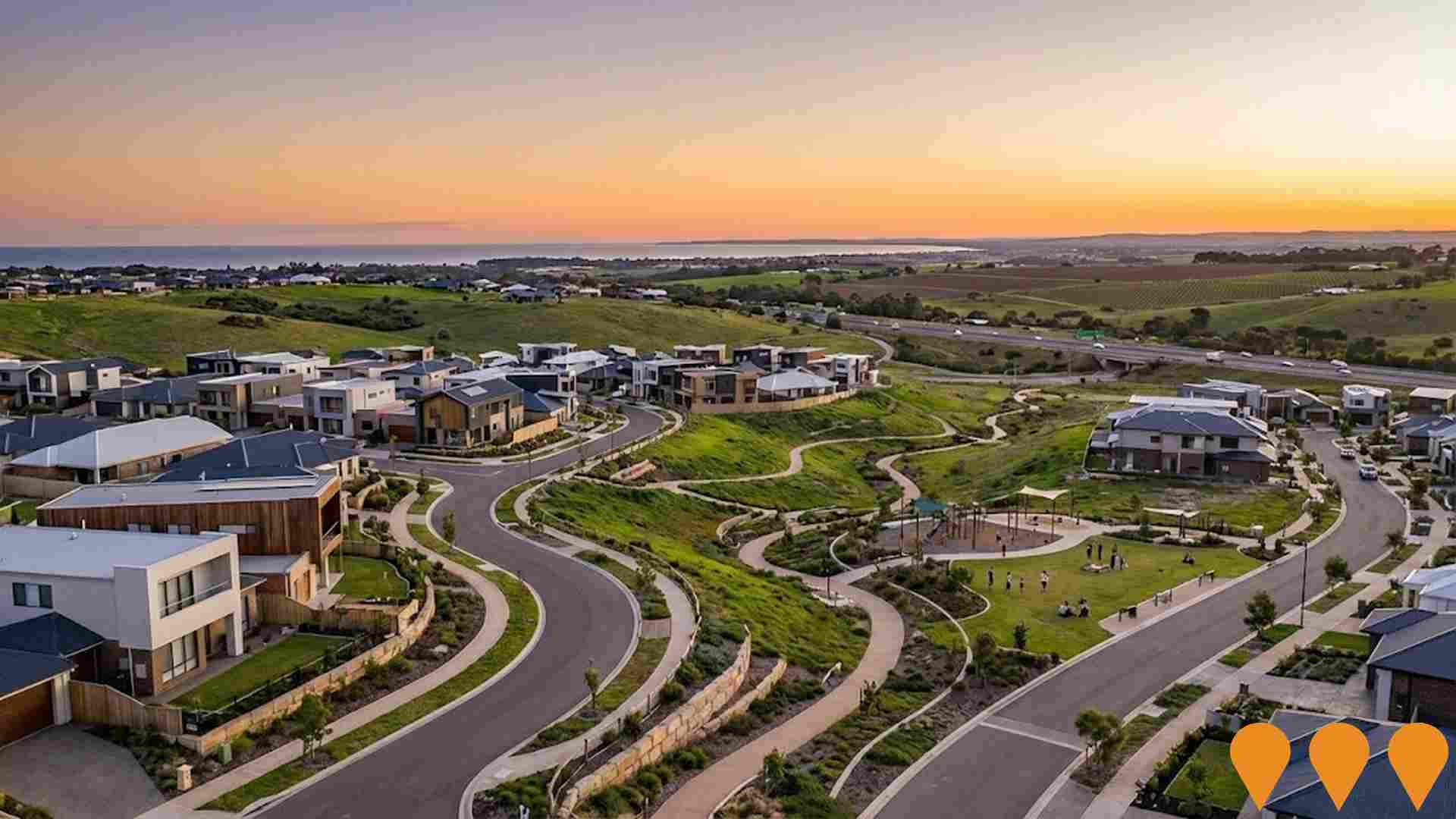
Noarlunga Master Planning Housing Project
A 22-hectare master-planned residential development delivering 626 new homes with a diverse mix of dwelling types including detached homes, townhouses and apartments. The project features a minimum of 28% affordable and social housing (including 80 social housing dwellings), and 12.5% new public open space. Designed by Holmes Dyer, the development targets a 5-Star Green Star Communities rating and emphasizes sustainability, extensive tree canopy coverage, and enhanced connectivity to nearby amenities including Colonnades Shopping Centre, Noarlunga TAFE, Noarlunga Hospital and Noarlunga Railway Station. Civil works by Winslow Constructors are underway with the first sales releases now on market. The community will become home to approximately 1,200 residents over a 7-10 year delivery period.
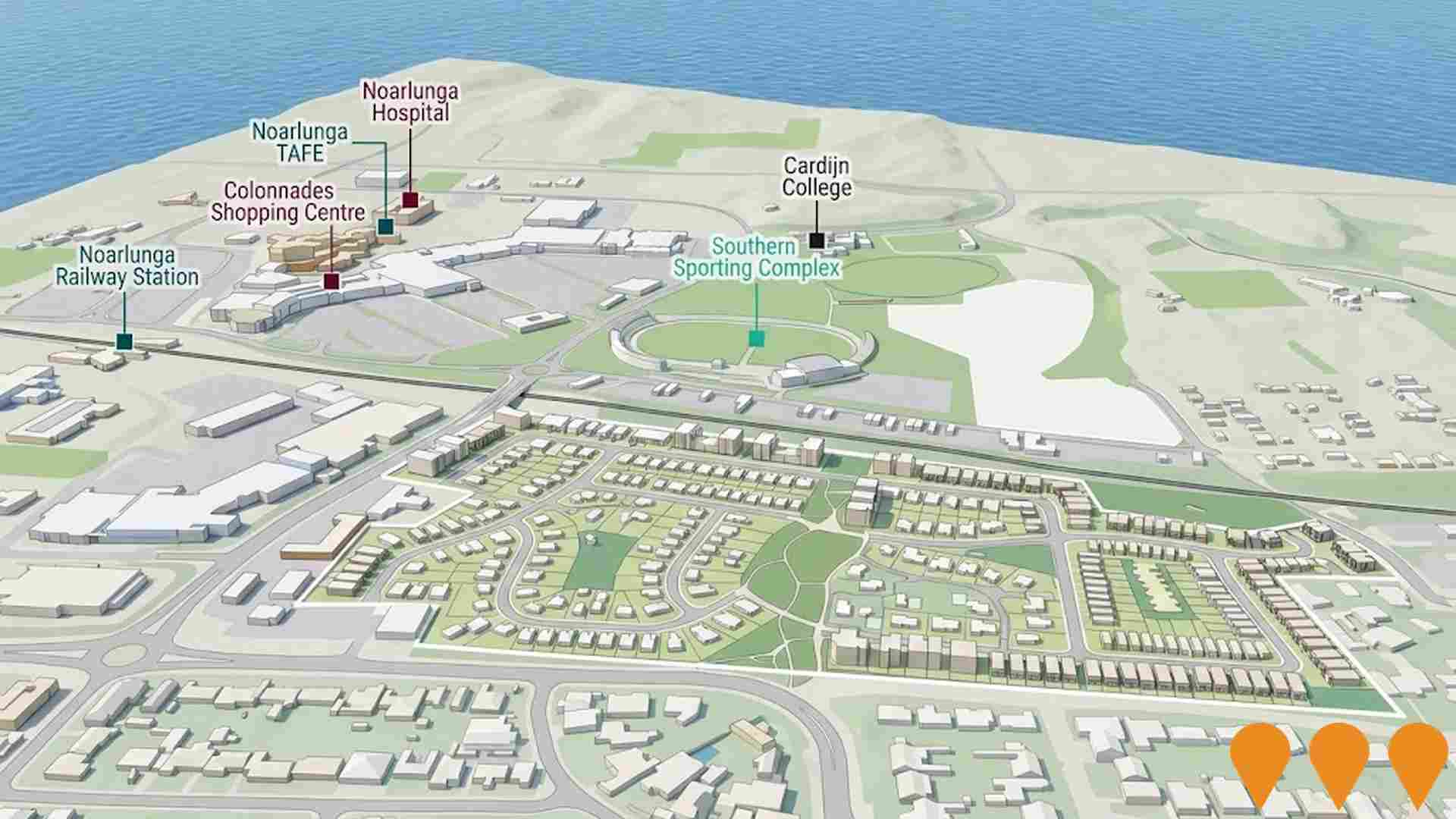
Majors Road Interchange
$120 million jointly funded project by Australian and South Australian governments creating new grade-separated interchange providing access to Southern Expressway from Majors Road. Features new on/off ramps, widening of Majors Road bridge from two lanes to six lanes with dedicated right turn lanes, signalised intersection improvements, new bike lanes and shared user paths, new underpasses for Patrick Jonker Veloway, upgraded traffic signals, widening of Majors Road from Southern Expressway to Lonsdale Highway/Ocean Boulevard to provide two through lanes in both directions, underground power lines, tree planting for 50% shade coverage, and realignment of the Patrick Jonker Veloway. Expected to support 245 full-time jobs during construction and provide improved access to Glenthorne National Park, Sam Willoughby International BMX Facility and Southern Soccer Facility. Construction by Acciona Construction Australia, completion expected end of 2025.
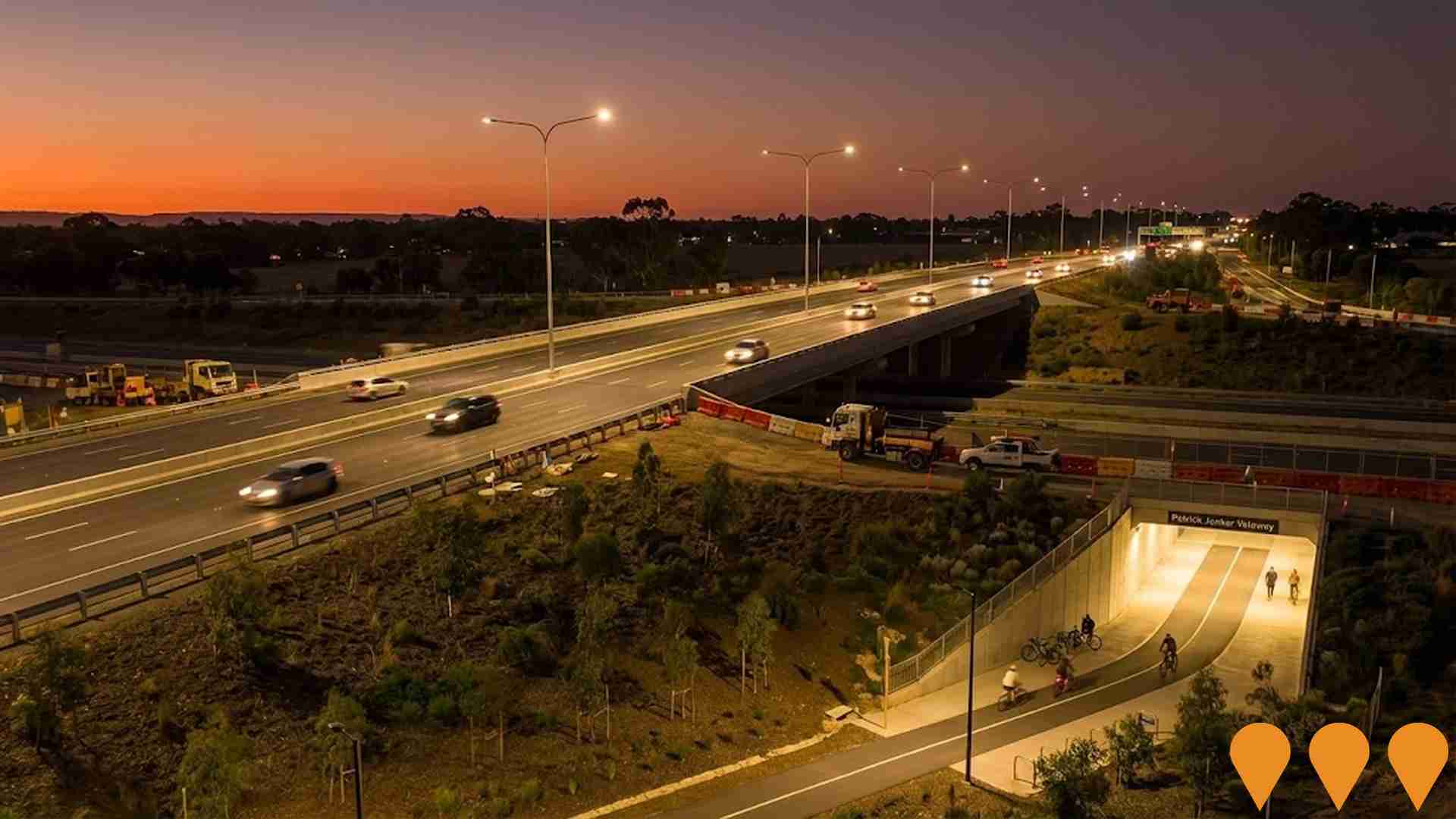
Adelaide Public Transport Capacity and Access
State-led program work to increase public transport capacity and access to, through and within central Adelaide. Current work is focused on the City Access Strategy (20-year movement plan for the CBD and North Adelaide) and the State Transport Strategy program, which together will shape options such as bus priority, interchange upgrades, tram and rail enhancements, and better first/last mile access.
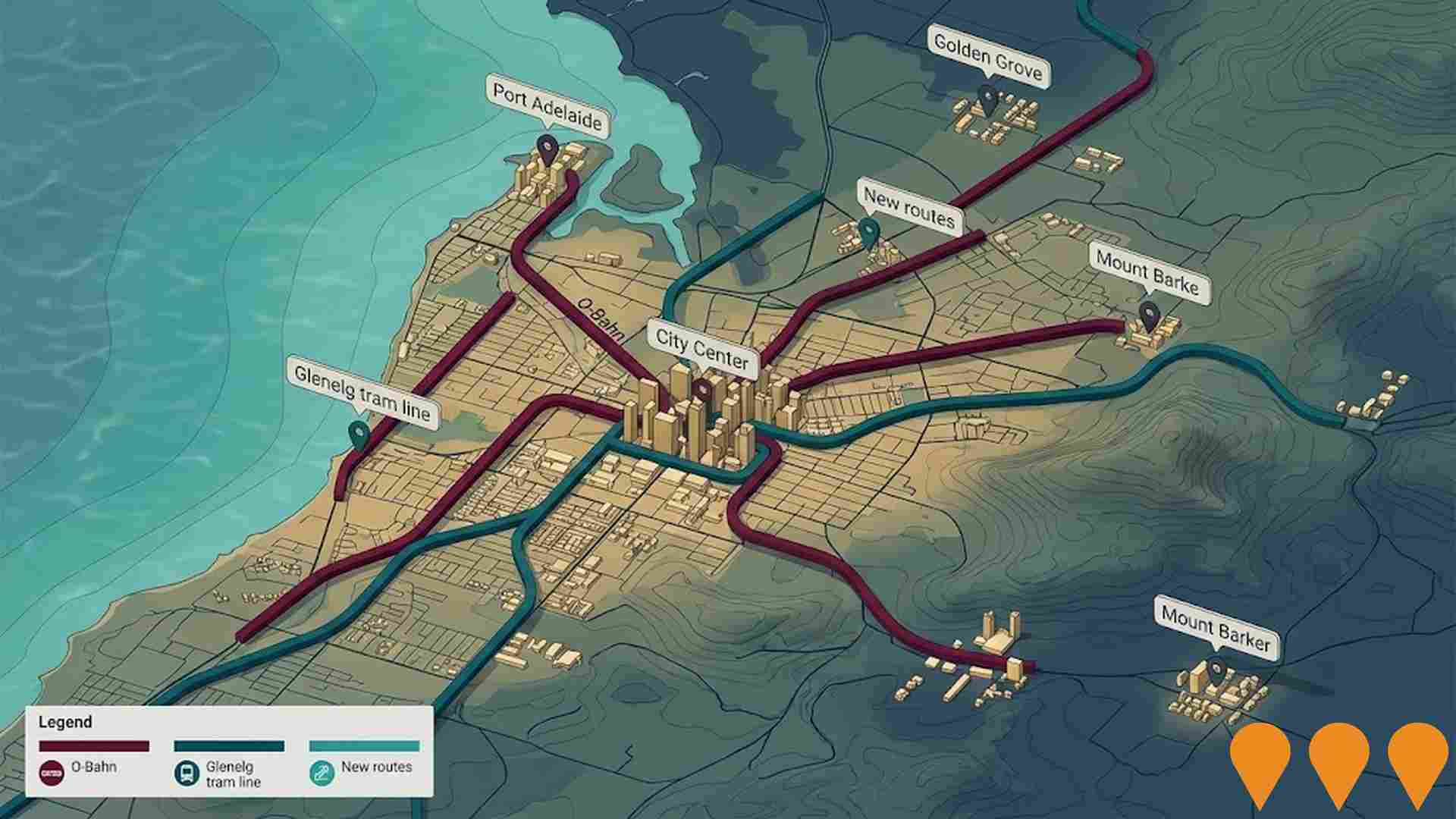
Main South Road Duplication Stage 1 - Aldinga Project
Part of Fleurieu Connections providing safer, faster journeys from Seaford to Aldinga. Supporting local tourism and communities. Aldinga Interchange construction underway with piling works, 12 x 40-tonne girders supporting bridge deck 26m long x 27m wide. 62 architectural panels and 86m anti-throw screens.

Sunset Residential Development
A 42-hectare master-planned residential community featuring 644 allotments with land sizes up to 540m2. The development includes 15% affordable and social housing outcomes, extensive green spaces including a major north-south walking trail connecting to Onkaparinga River Recreation Park. Located in a prime coastal position with proximity to South Australian beaches and McLaren Vale wine region.
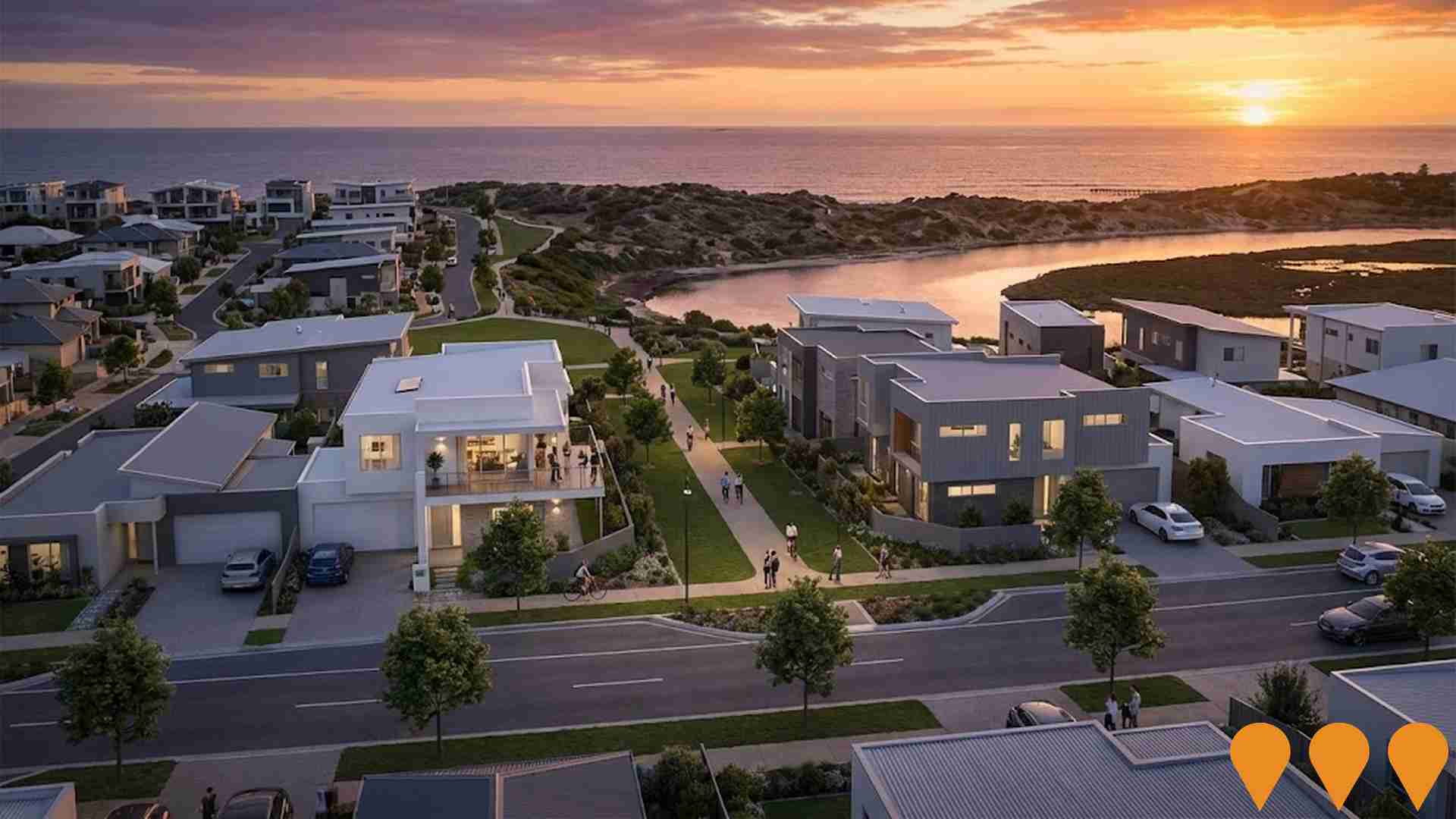
Noarlunga Residential Development
Noarlunga is a 22 hectare master planned residential community on land east and west of Lovelock Drive in Noarlunga Downs. The project will deliver more than 626 new homes including detached houses, townhomes, apartments and at least 28 percent affordable and social housing, including new SA Housing Authority homes. The plan provides new streets, public open space, green links and improved connections to Colonnades Shopping Centre, Noarlunga TAFE, Noarlunga Hospital and the rail station, and is targeting a 5 Star Green Star Communities rating. Civil works are underway, with house construction planned to commence from 2026 and full build out expected by around 2031.

Employment
Christies Beach shows employment indicators that trail behind approximately 70% of regions assessed across Australia
Christies Beach has a skilled workforce with essential services sectors well represented. The unemployment rate was 6.8% in June 2025, with an estimated employment growth of 3.0% over the past year.
As of this date, 5,672 residents were employed while the unemployment rate was 2.8% higher than Greater Adelaide's rate of 4.0%. Workforce participation was lower at 57.7%, compared to Greater Adelaide's 61.7%. The dominant employment sectors among residents included health care & social assistance, construction, and retail trade. Christies Beach showed strong specialization in construction with an employment share of 1.4 times the regional level.
Conversely, professional & technical services had lower representation at 4.4% compared to the regional average of 7.3%. The area appeared to offer limited local employment opportunities based on Census data comparison between working population and resident population. In the year to June 2025, employment levels increased by 3.0%, while labour force increased by 2.7%, causing a decrease in unemployment rate by 0.3 percentage points. By comparison, Greater Adelaide recorded employment growth of 2.1% with marginal unemployment increase. Jobs and Skills Australia's national employment forecasts from May 2025 projected national employment growth at 6.6% over five years and 13.7% over ten years. Applying these projections to Christies Beach's employment mix suggested local growth of approximately 6.5% over five years and 13.5% over ten years, though these are simple weighted extrapolations for illustrative purposes and do not account for localized population projections.
Frequently Asked Questions - Employment
Income
Income figures position the area below 75% of locations analysed nationally by AreaSearch
AreaSearch's latest postcode level ATO data for financial year 2022 shows that Christies Beach has incomes below the national average. The median income is $47,926 and the average income is $55,004. In comparison, Greater Adelaide has a median income of $52,592 and an average income of $64,886. Based on Wage Price Index growth of 12.83% since financial year 2022, current estimates for Christies Beach would be approximately $54,075 (median) and $62,061 (average) as of September 2025. The 2021 Census indicates that household, family, and personal incomes in Christies Beach fall between the 15th and 20th percentiles nationally. The income bracket of $800 - $1,499 dominates with 29.0% of residents (3,377 people), unlike the metropolitan region where the $1,500 - $2,999 bracket dominates with 31.8%. Housing affordability pressures are severe in Christies Beach, with only 81.5% of income remaining, ranking at the 13th percentile.
Frequently Asked Questions - Income
Housing
Christies Beach is characterized by a predominantly suburban housing profile, with a higher proportion of rental properties than the broader region
Christies Beach dwelling structures, as per the latest Census, consisted of 80.9% houses and 19.1% other dwellings (semi-detached, apartments, 'other' dwellings), compared to Adelaide metro's 80.9% houses and 19.1% other dwellings. Home ownership in Christies Beach was at 29.5%, with mortgaged dwellings at 33.3% and rented ones at 37.1%. The median monthly mortgage repayment was $1,394, below Adelaide metro's average of $1,452, while the median weekly rent was $320, compared to Adelaide metro's $314. Nationally, Christies Beach's mortgage repayments were significantly lower than the Australian average of $1,863, and rents were substantially below the national figure of $375.
Frequently Asked Questions - Housing
Household Composition
Christies Beach features high concentrations of lone person households and group households, with a lower-than-average median household size
Family households constitute 63.1 percent of all households, including 21.1 percent couples with children, 25.0 percent couples without children, and 15.6 percent single parent families. Non-family households comprise the remaining 36.9 percent, with lone person households at 32.9 percent and group households making up 4.1 percent of the total. The median household size is 2.2 people, which is smaller than the Greater Adelaide average of 2.5.
Frequently Asked Questions - Households
Local Schools & Education
Educational outcomes in Christies Beach fall within the lower quartile nationally, indicating opportunities for improvement in qualification attainment
The area's university qualification rate is 17.8%, significantly lower than the Australian average of 30.4%. Bachelor degrees are most common at 12.7%, followed by postgraduate qualifications (3.1%) and graduate diplomas (2.0%). Trade and technical skills are prominent, with 40.8% of residents aged 15+ holding vocational credentials - advanced diplomas (10.4%) and certificates (30.4%). A total of 24.3% of the population is actively pursuing formal education, including 8.6% in primary, 6.3% in secondary, and 4.1% in tertiary education.
The area has five schools with a combined enrollment of 1,189 students, operating under typical Australian school conditions (ICSEA: 989) and offering balanced educational opportunities. All five schools focus exclusively on primary education, with secondary options available in surrounding areas. School places per 100 residents stand at 10.2, below the regional average of 13.6, indicating some students may attend schools in adjacent areas.
Frequently Asked Questions - Education
Schools Detail
Nearby Services & Amenities
Transport
Transport servicing is moderate compared to other areas nationally based on assessment of service frequency, route connectivity and accessibility
Christies Beach has 64 active public transport stops, all of which are bus stops. These stops are served by 19 different routes that together facilitate 1,122 weekly passenger trips. The accessibility of these services is rated as good, with residents typically residing just 203 meters from the nearest stop.
On average, there are 160 trips per day across all routes, which equates to approximately 17 weekly trips per individual stop.
Frequently Asked Questions - Transport
Transport Stops Detail
Health
Health performance in Christies Beach is well below average with prevalence of common health conditions notable across both younger and older age cohorts
Christies Beach faces significant health challenges, with common conditions prevalent across both younger and older age groups. Private health cover is low at approximately 48% of the total population (~5,544 people), compared to the national average of 55.3%.
Mental health issues and arthritis are the most common medical conditions in the area, affecting 11.4% and 10.1% of residents respectively. However, 59.8% of residents report being completely clear of medical ailments, slightly lower than Greater Adelaide's 62.9%. The area has a higher proportion of seniors aged 65 and over at 20.4% (2,376 people). Health outcomes among seniors present some challenges, largely aligning with the general population's health profile.
Frequently Asked Questions - Health
Cultural Diversity
In terms of cultural diversity, Christies Beach records figures broadly comparable to the national average, as found in AreaSearch's assessment of a number of language and cultural background related metrics
Christies Beach's cultural diversity aligns with its wider region, with 74.9% born in Australia, 88.8% being citizens, and 93.4% speaking English only at home. Christianity is the predominant religion, comprising 35.2%. The 'Other' category shows slight overrepresentation at 0.8%, compared to Greater Adelaide's 0.7%.
Top ancestry groups are English (36.4%), Australian (24.9%), and Scottish (7.8%). Notable divergences include Dutch (1.9% vs regional 1.7%), Welsh (0.8% vs 0.8%), and German (5.4% vs 5.4%).
Frequently Asked Questions - Diversity
Age
Christies Beach hosts an older demographic, ranking in the top quartile nationwide
Christies Beach has a median age of 42, which is slightly higher than Greater Adelaide's figure of 39 and notably higher than the national average of 38. The age group of 55-64 years old comprises 12.5% of Christies Beach's population, outpacing Greater Adelaide's percentage. Conversely, the 5-14 age cohort makes up only 10.2%. According to the 2021 Census, the 35-44 age group has increased from 12.3% to 13.8%, while the 45-54 cohort has decreased from 13.2% to 11.9%. By 2041, demographic projections indicate significant changes in Christies Beach's age profile. The 45-54 group is expected to grow by 20%, adding 284 people and reaching a total of 1,675 residents from the previous count of 1,390. Meanwhile, the 55-64 group is projected to grow by 5%, with an increase of 77 residents.
